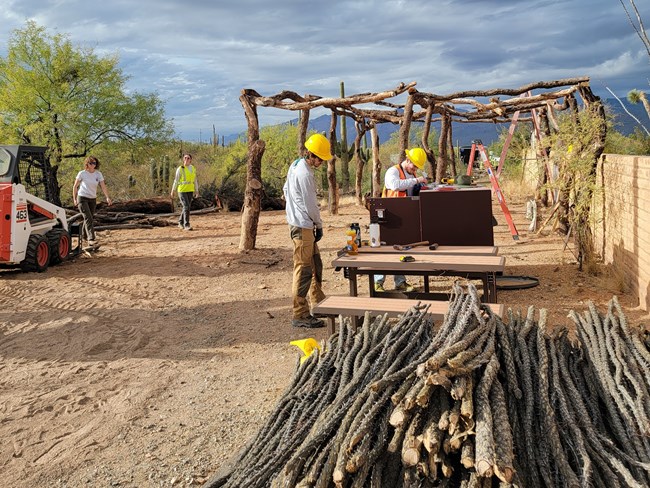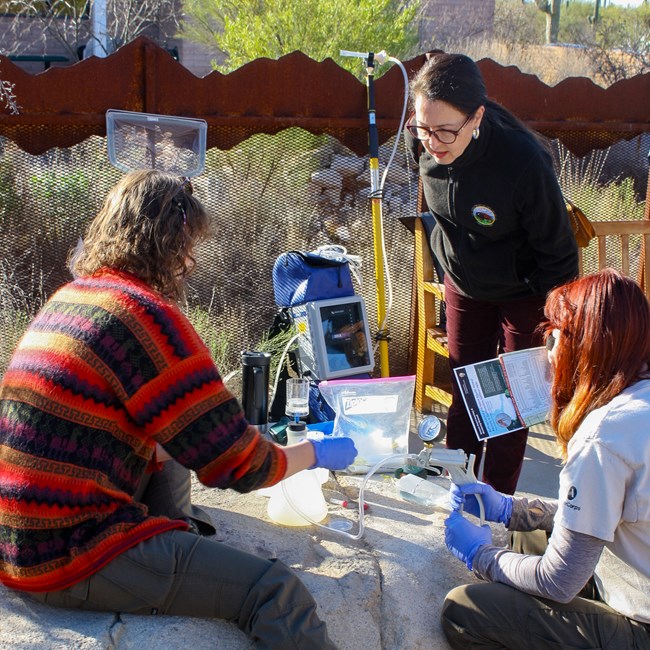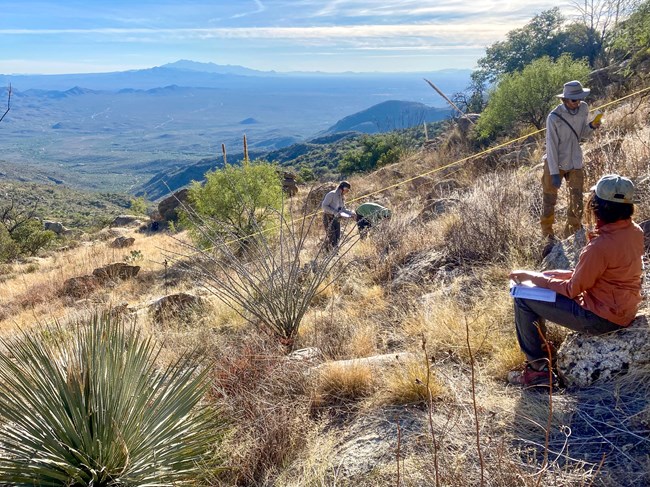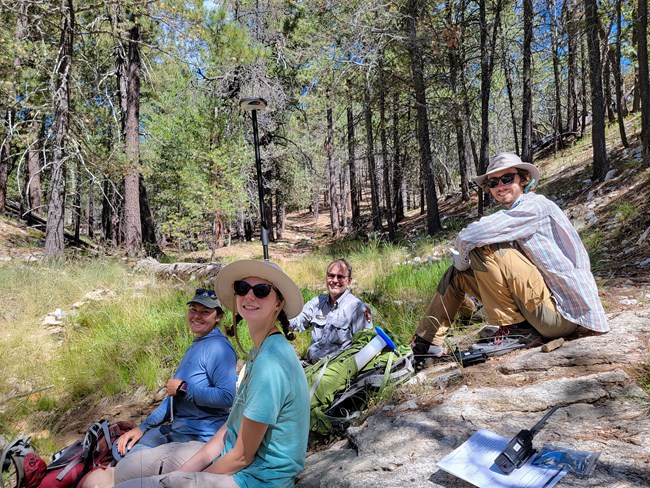Last updated: May 31, 2024
Article
The Heliograph: Spring 2024

The Heliograph is the newsletter for the Sonoran Desert Network and Desert Research Learning Center.
The Sonoran Desert Network is an Inventory & Monitoring Network that works to collect long-term inventory and monitoring data on natural resources in eleven national parks in the Sonoran Desert for the purpose of aiding parks in natural resource management. The Desert Research Learning Center is the central office of this network, located in Tucson, Arizona. It supports network operations and offers outdoor education opportunities to local student groups.
Testing Treatments for Mitigating Climate-Change Effects on Adobe Structures
After five years of hands-on research at the Desert Research Learning Center, Sonoran Desert Network (SODN) partners [Southern Arizona Office staff Sharlot Hart and Kara Raymond] published a paper analyzing the effectiveness of various treatments to adobe structures. The results of their hard work provide data-backed recommendations to cultural resource managers as many adobe structures face increased threats of erosion under climate change. You can read about this project on the SODN website, in Heritage—a cultural and natural heritage science journal—or on our social media.

NPS/E. SCHNAUBELT
Insect Conservation in the National Parks
The Glowworms of Tumacácori Would Like a Word
After an inspiring conversation with Tony Palmer, an entomologist at Tumacácori National Historical Park, former SODN writer Alice Wondrak Biel stands up for insects. In this article about the fascinating bioluminescing earthworms and fireflies that live at Tumacácori, climate change and dark skies are identified as important factors regarding the impending “insect apocalypse.” Highlighting (pun intended!) the importance of insects to our daily comfort—and survival—she makes the case that insects deserve to be treated as wildlife, not “creepy crawlies.”

Inflation Reduction Act Funding in SODN
Globally, amphibians and aquatic reptiles are among the most threatened taxa on Earth due to the compounding effects of climate change, water extraction, and habitat decline. In the Southwest, another primary threat is the invasive American bullfrog (Lithobates catesbeianus)—a voracious non-native predator called the “Great White Shark of the Southwest”—and the diseases they carry into the watersheds of parks, including chytrid fungus and ranaviruses. To meet this challenge and protect native species, land managers must know the distribution and abundance of native species, bullfrogs, and these threatening diseases. Through IRA funding, we can collect environmental DNA (eDNA) from surface waters to model the status and distributions of these important organisms. eDNA sample identification is on-going, and these results will inform our action plans for bullfrog control and native species recovery. We are also developing an early detection/rapid response protocol for responding to future bullfrog sightings in parks. To learn more, visit our project page.

NPS/E. SCHNAUBELT
Ramadas of the Southwest
In November of 2023, SODN staff finished building a second ramada at the Desert Research Learning Center (DRLC). This style of ramada is commonly built by Tohono O’odham people to provide shade around living and harvesting areas. We admire the resourcefulness of this ramada design and deeply respect the place-based wisdom indigenous people hold in the Sonoran Desert. Does your park have ramadas? Read more about the history of shade-making in the desert.
Staff Updates
In 2023, SODN said goodbye to several staff, volunteers, and interns who either finished their terms, followed new positions, or started exciting travel. Each of them left a wonderful impact on SODN and the DRLC, and we appreciate all their hard work!
- Alicia Bakken, Biological Science Technician
- Alice Wondrak Biel, Science Communication Writer/Editor (new contact: Tani Hubbard)
- Joe Black, Biological Science Technician
- Owen Brown, Volunteer/Stanford University CareerEd Fellow
- Elise Dillingham, Wildlife Protocol Lead (new contact: Jessica McGeverly (previously McGarey)
- Laura Falk, Aquatics Protocol Crew Lead (new contact: Andy Hubbard)
- Brandon Gottung, Biological Science Technician
- Kate Mcnicholas, SCA Aquatics Intern
- Naomi Oberg, Biological Science Technician
- Sam Olivares-Mejia, SIP Data Management Intern
- Dominik Wolf, Wildlife International Volunteer in Parks
SODN is very excited to welcome new interns and staff:

Eva is a Fire Ecology Scientists-in-Parks (SIP) intern at the DRLC working with SODN on quality control and analysis of fire effects data in national parks. She graduated from the University of Notre Dame in Spring 2023 with a major in Environmental Science and a minor in Data Science. She plans to start a PhD at Northern Arizona University in the Fall 2024, working on modeling climate legacies and forecasting ecological changes in response to climate change and extreme events. She is also interested in using Environmental Data Visualization as a form of science communication to make climate information accessible to broad audiences. In her free time, Eva enjoys being active, playing guitar, making jewelry, and visiting her friends and family back in the Midwest.
Cassidy first started her field work career in the summer of 2019 as an intern working on the Whitebark Pine project with the Klamath Inventory. Discovering her passion, she zoned in on botany and herpetology, studying botany at Oregon State University and herpetology at the University of Arizona. After completing her studies, she was a project lead for the Bureau of Land Management, working on the Assessment, Inventory and Monitoring (AIM) protocol. She then transitioned to the NPS Inventory & Monitoring Division through Tucson Audubon Society, and is a crew lead for SODN's Bullfrog Control and Native Aquatic Animal Recovery project. In her spare time, Cassidy loves to go “herping” (searching for herpetofauna), trail running, and biking. Her inbox is always open to herpetology questions.
Elora returned to work with SODN in April as the Aquatic Ecology Crew Lead, after spending a winter in Yosemite National Park collaring and tracking endangered Sierra Nevada fishers. She spends most of her free time outside, hiking, backpacking, rock climbing, skiing, biking, kayaking, and simply exploring new places! She previously spent a year working with the Southwest Network Collaboration (SWNC) as a SIP (Scientists-in-Parks), traveling to more than 17 NPS units to help with a variety of long-term monitoring protocols. Elora first moved to the Southwest in 2022 from Oregon, and quickly fell in love with the unique landscapes and amazing biological and ecological diversity! She is very excited for this new chapter and can’t wait to explore even more of the desert.
The natural world has always held a special place in Lauren’s heart. She cultivated her love for the environment while exploring the hills of her hometown in Southern California, catching lizards, rolling around in dirt and admiring the swallows nesting in her childhood home. Now, after a decade of living in the Sonoran Desert, Lauren is still doing what she loves most—exploring the natural world—as a field technician with SODN. She joined the vegetation monitoring crew in August 2023 after a season surveying plants and soil for the Bureau of Land Management. She discovered her deep passion for conservation while working as a journalist shadowing a trail crew working on the Mount Baldy Trail in the Apache-Sitgreaves National Forests. Not long after she published that story, she left journalism and joined a full-time trail crew to follow her passion for the outdoors. Lauren’s appreciation for plants sprouted during her years with Wild Arizona, a local conservation nonprofit, where she built and restored backcountry trails across some of the state’s most spectacular mountain ranges. When she’s not collecting soil samples for work, you can find Lauren with binoculars in hand, looking for birds, trail running, throwing clay in the ceramics studio, or walking her dog, Etta.
Based in Tucson, Elizabeth is transitioning to her new role as Science Communications Technician from her recently completed SIP internship as Science Communication Assistant for the Southwest Network Collaboration (SWNC). She is passionate about sharing the unique knowledge SWNC has about nature in its parks. When not writing reports or designing posters, she loves joining crews in the field to help collect data and document the scientific process.
Elizabeth previously worked in her home state of California at Yosemite National Park, helping digitize their historic map collection. She graduated summa cum laude from Macalester College (Saint Paul, MN) in 2022 with a BA in Applied Math and Statistics and minors in Physics and Environmental Studies. Her hobbies include traveling, pickleball, card and board games, contra and swing dancing, and—of course!—hiking and camping.

NPS/E. SCHNAUBELT
At the Desert Research Learning Center
The Desert Research Learning Center has hosted multiple workshops, trainings, tours, community science events, and programs this year. Saguaro National Park, the National Park Service's Southern Arizona Group, National Park Service's Historic Preservation Training Center, US Fish and Wildlife Service, The University of Arizona, Ironwood Tree Experience, National Outdoor Leadership School (NOLS), Mission Gardens, the National Park Foundation, and other organizations have all used our facility or have partnered with us for events. We are grateful for all our relationships with the above organizations and look forward to working with these groups and more in 2024.
Recent events hosted at the DRLC include:
- An Eagle Scout project, in which Scouts helped complete a new campground at the DRLC for use in future programs.
- A visit from Shannon Estenoz, the Department of Interior's Assistant Secretary for Fish, Wildlife, and Parks, who was in town to announce IRA funding going towards parks in Arizona.
- An in-person gathering for the annual Inventory & Monitoring Division Program Managers’ Meeting.
- A research field trip for the Ecological Society of America;s college-education program, Strategies for Ecology Education, Diversity and Sustainability (SEEDS).
Recent Reports Published
SODN’s climate-and-water reports summarize the network’s analyses of weather, groundwater, and, in some parks, springs data. Recent reports provide information on Water Year 2022 (10/1/2021–9/30/2022). This monitoring helps us understand and contextualize changes to park resources over time. The data analyzed include precipitation, temperature, groundwater levels, drought severity and extent, and–in parks where we collect spring data–spring condition, water quality and quantity, water chemistry, and discharge. Data are compared to 1991–2022 averages as context for environmental trends. Results from our eDNA collection are also discussed in these reports. These reports can be found on the SODN website and each park’s Science & Research page.
- Casa Grande Ruins National Monument
- Chiricahua National Monument
- Coronado National Memorial
- Fort Bowie National Historic Site
- Gila Cliff Dwellings National Monument
- Montezuma Castle National Monument
- Organ Pipe Cactus National Monument
- Saguaro National Park
- Tonto National Monument
- Tumacacori National Historical Park
- Tuzigoot National Monument
Sonoran Desert Network Welcomes International Volunteers in Parks
One of SODN’s favorite traditions is welcoming International Volunteers in Parks (IVIPs) to Tucson for internships of 21–52 weeks. Our previous IVIPs have been from France, Germany, Australia, the Netherlands, and Romania. If you or someone you know is interested in gaining premier fieldwork experience while furthering botanical or soils skills, read more about this program on our Interns & Volunteers webpage.
Project Updates

NPS/A. WASHUTA
Vegetation and Soils
The uplands monitoring crew is currently processing the data collected during the 2023 field season and planning for more sampling in the fall. In 2024 the crew will visit Chiricahua NM, Coronado NMEM, Saguaro NP, Tonto NM, and the Guevavi and Calabazas units of Tumacácori NHP. The crew will also visit monitoring sites across Pima County as part of our continued partnership with the Pima County Office of Sustainability and Conservation and Tucson Audubon Society.

NPS/E. SCHNAUBELT
Springs
SODN crew members have kept up with springs data collection fantastically despite currently lacking a crew lead. Spring 2024 marks the completion of our seventh year of perennial springs monitoring. Currently we are wrapping up the web reporting of our 2022 springs data and processing the 2023 data. The comparison between these two years is staggering: 2022 was one of the wettest years in the last 100 years, while 2023 was one of the driest. We have certainly experienced climate whiplash in the Sonoran Desert.
We continue to integrate environmental DNA (eDNA) collection in our springs monitoring protocol, as began in 2022. Springs and tinajas are locations of high traffic for many desert species, making them excellent sampling locations for eDNA. A new tool in this protocol is an eDNA backpack sampler, allowing us to sample in the Gila River (Gila Cliff Dwellings NM), Quitobaquito (Organ Pipe Cactus NM), and Montezuma Well (Montezuma Castle NM) like never done before. Excitingly, the eDNA project has received much attention from the press. For example, the Arizona Daily Star wrote this piece on our work.

NPS
Wildlife
For the first time, "AI soft sorting" has been implemented as part of the terrestrial wildlife monitoring protocol. The AI software sorts out false triggers from the images captured during deployment, which saves us days' worth of work during the mammal identification process. Check out our Photo Gallery containing some of the images we have captured in Saguaro National Park West, Organ Pipe Cactus National Monument, and Chiricahua National Monument.
Streams
Streams fieldwork has been on hold since December 2023. At that time, following the departure of key staff members and a facing a large data backlog, the Southwest Network Collaboration (SWNC), which includes SODN, voted to temporarily suspend fieldwork associated with streams protocols. This temporary suspension will allow SWNC staff to review and analyze existing streams data and identify near- and long-term staffing needs and strategies for sustainably implementing streams monitoring in the future.
Tags
- sonoran desert network
- sodn
- casa grande ruins national monument
- chiricahua national monument
- coronado national memorial
- fort bowie national historic site
- gila cliff dwellings national monument
- montezuma castle national monument
- organ pipe cactus national monument
- saguaro national park
- tonto national monument
- tumacacori national historical park
- tuzigoot national monument
- newsletter
- heliograph
